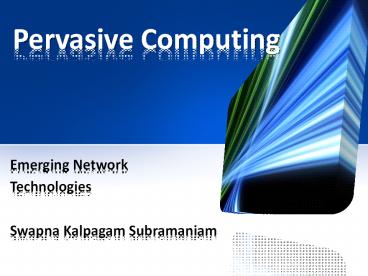Pervasive Computing - PowerPoint PPT Presentation
Title:
Pervasive Computing
Description:
Pervasive Computing Outline History What is Pervasive Computing? Need for this technology Principles Key areas & components Areas of Application Projects and future ... – PowerPoint PPT presentation
Number of Views:216
Avg rating:3.0/5.0
Title: Pervasive Computing
1
Pervasive Computing
- Emerging Network
- Technologies
- Swapna Kalpagam Subramaniam
2
Outline
- History
- What is Pervasive Computing?
- Need for this technology
- Principles
- Key areas components
- Areas of Application
- Projects and future work
- Survey and Challenges
- References
3
History
- The most profound technologies are those that
disappear. They weave themselves into the fabric
of everyday life until they are indistinguishable
from it. - - Mark Weiser (1952-1999) (Xerox PARC)
- The founder of Ubiquitous computing
4
Weisers principles
- The purpose of a computer is to help you do
something else - The best computer is a quiet, invisible servant
- The more you can do by intuition the smarter you
are- the computer should extend your unconscious - Technology should create calm.
5
Pervasive Computing
- Pervasive Existing everywhere
- It is also referred as Ubiquitous computing,
ambient intelligence, everyware. - Environments saturated with computing and
communication capability, yet gracefully
integrated with human users - M. Satyanarayanan - People and environments augment with
computational resources that provide information
and services when and where desired - Mark Weiser
6
Need for this technology?
SIZE
NUMBER
7
Principles of Pervasive Computing
- Decentralization
- Diversification
- Connectivity
- Simplicity
- One of the central concepts of pervasive
computing is the automatic organization of
technical systems to enable capabilities that are
important to people in a given environment
8
Key areas
- Devices
- Pervasive Networking
- Pervasive Middleware
- Pervasive Applications
Pervasive Middleware
Applications
Applications
Pervasive Networking
Pervasive device
User interface
Applications
Applications
9
Components
- Proximity wireless (Bluetooth, WLAN, low-power
radios, optical, non-RF) - Near field access( RFID,NFC)
- Sensors and related networking( biometrics,
wearable sensors, environmental sensors) - Pervasive networking(Peer-2-peer, ad-hoc,
communication middleware, self-healing) - Proximity-cellular interactions (
vertical-roaming, multiple interfaces terminals) - Distributed application middleware (UPnP, Jini,
Web services, Service discovery (SDP)) - Pervasive security( distributing trust, virus
protection, platform security, visitor scenarios) - Distributed applications( tools, languages,
scripts) - Location and context awareness (presence,
location awareness technology, middleware)
10
Components
- User-interfaces (real-world UI, UI technologies,
multi-modal, designs) - Terminals and enabling hardware( OS, device
architecture, processor architecture) - Applications and services
- Market opportunities (Acceptance, business
models, scenarios) - Standardization( DLNA, MBOA, IEEE, NFC,OMA)
- Source Pervasive computing group, Nokia research
11
Areas of application
- Logistics
- Motor traffic
- Military
- Production
- Smart homes
- E-commerce
- Inner security
- Medical Technology
12
Areas of applications
13
SmartHouse
- Smart Houses Technology and intelligence weaved
into the animate and inanimate objects in a house
to share and percept information to provide
comfortable and easy living along with valuable
capabilities to maintain household. - UFL project
- http//www.icta.ufl.edu/gatortech/index2.html
14
Gator Tech Smarthouse
15
Pervasive computing taxonomy
16
Projects and future work
- AURA CMU project
- Design, implement, deploy, and evaluate a
large-scale system demonstrating the concept of a
"personal information aura that spans wearable,
handheld, desktop and infrastructure computers. - Oxygen MIT project
- Speech and vision technologies, Automation,
knowledge access and collaboration technologies - Portolano - UW project
- Testbed for investigating users intentions
via their actions in the environment and their
interactions with everyday objects. - Sentient Computing ATT Cambridge University
- The project explores user interfaces that
employ sensors and resource status data to
maintain a world model shared by users and
applications
17
Projects and future work
- Endeavour UC, Berkeley
- Focuses on the specification, design, and
prototype implementation of a planetscale,
self-organizing, and adaptive information
utility - Cooltown Hewlett Packard
- Create a virtual bridge between mobile
users, physical entities and electronic services. - EasyLiving MS Research Vision Group
- Intelligent environments addressing
middleware, geometric world modeling, perception,
and service description. - WebSphere Everyplace - IBM
- Working on middleware that extends its
WebSphere software platform. - Many others in pipeline
18
Projects Future work
- Examples from everyday appliances
- Wearable computers
- Gamers chair
- Optical keyboards
- AI based support/virtual systems
- Integration between PDA/phones/projectors/systems
19
Expert Survey - BSI
20
Expert Survey - BSI
Communication technology
21
Challenges
- Scalability
- Heterogeneity Interoperability
- Integration
- Invisibility
- Perception Context awareness
- Smartness Context management
- Security Privacy
22
Advantages
- Socialization
- Decision-making
- Emergent Behavior
- Information processing
- Enhancing Experience
- Convergence
23
Future works
- Pervasive healthcare
- Smartdust technology in defense
- Smarthouses deployment
- Smartclassroom environments
- Pervasive traffic systems
- Everyday intelligent personal spaces
24
References
- Pervasive Computing (wikipedia)
- Mark Weiser, The Computer for the 21st Century,
1988 - M Satyanarayanan, CMU Pervasive Computing
Vision and Challenges, IEEE 2001 - BSI Federal Office for Information security
survey on pervasive computing - Debashis Saha, Pervasive Computing A Paradigm
for the 21st Century - Dimitris Kalofonos, Pervasive Computing
Group(PCG) presentation, Nokia Research Center - Aura http//www.cs.cmu.edu/aura/
- Project Oxygen http//oxygen.lcs.mit.edu
- GatorTech Smarthouse http//www.icta.ufl.edu/gt.ht
m1
25
Q A
26
Additional Analysis of factors and impacts of
pervasive features































